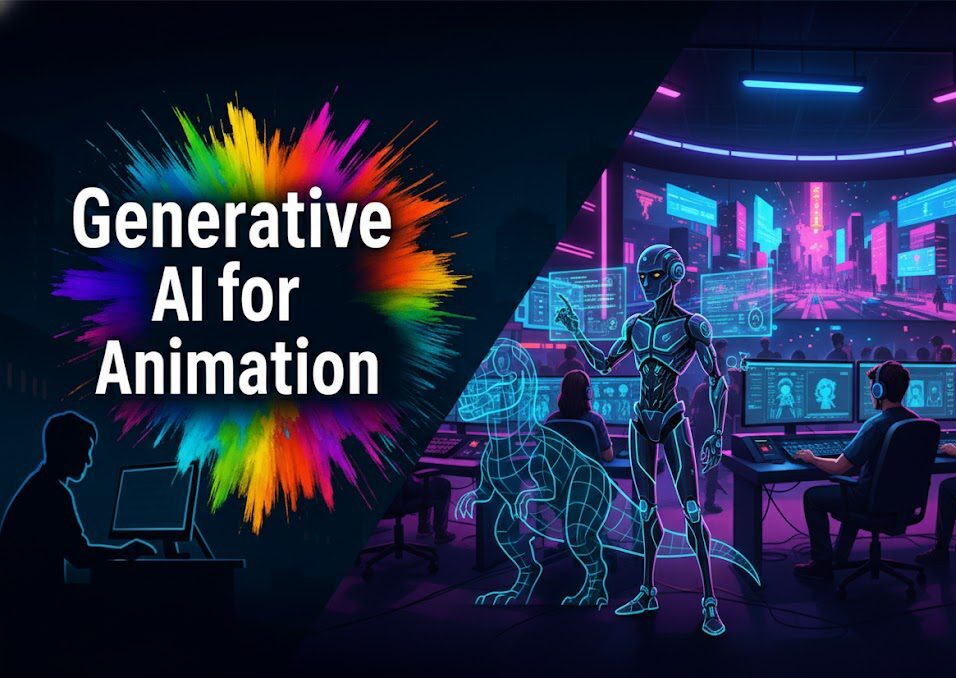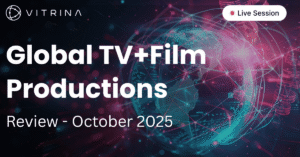Generative AI for Animation: Strategic Impact on the M&E Supply Chain

Introduction
The introduction of Generative AI for animation has evolved beyond a technological curiosity to become a central strategic consideration for every senior executive in the Media & Entertainment (M&E) sector.
This technology represents a fundamental shift in the economics of content creation, promising radical acceleration and cost reduction across the production lifecycle.
For decision-makers responsible for major production slates, the challenge is no longer if to adopt this technology, but how to integrate it responsibly while managing the associated financial, legal, and personnel risks.
Executives lack clear, verifiable market intelligence on the most capable vendors, the true return on investment (ROI) for specific Generative AI tools, and the IP risks associated with the disparate training data used by various service providers. Navigating this fragmented landscape without a clear view of the global supply chain is a significant strategic liability.
Vitrina is the critical enabler of this transition, offering the data-driven clarity required to vet new partners, understand market penetration, and strategically integrate cutting-edge production services.
This guide provides a strategic framework for understanding Generative AI for animation’s impact across the production pipeline, from automating time-intensive tasks to managing the complex ethical and structural challenges of this technology.
Key Takeaways
| Core Challenge | Fragmented data makes it difficult for M&E executives to vet Generative AI animation vendors and integrate technology with confidence. |
| Strategic Solution | Developing a clear framework to assess GenAI’s tactical use cases, market growth, and associated IP and labor risks. |
| Vitrina’s Role | Providing executive-level insights and company profiling to enable data-driven due diligence and partner selection. |
The Generative AI for Animation Value Chain
Generative AI (GenAI) refers to a class of advanced machine learning algorithms capable of producing novel content—such as video, images, or audio—by learning patterns from massive datasets.
Unlike traditional automation, GenAI can create nuanced, context-aware, and dynamic results, effectively mimicking human decision-making in the creative process, according to a report by Spiel Creative.
This capability is moving the animation sector from a highly manual craft toward a computational art form.
The market size reflects this disruptive potential. The Generative AI for animation market is projected to reach approximately $28.1 Billion by 2033, growing at a CAGR of 36.2% from 2024, according to Market.us.
This growth underscores an executive-level consensus: the future of animation production hinges on this technology.
Core Technology Primer: The Engine of Creation
The foundation of animation-focused GenAI rests on several key models:
- Generative Adversarial Networks (GANs): These networks use two competing neural networks—a generator and a discriminator—to create highly realistic outputs, often used for generating lifelike textures, realistic scenes, and physical phenomena like fire or water, notes E2E Networks.
- Transformers: These models are highly adaptable, excelling at analyzing nuanced patterns in large datasets to produce animated sequences that are contextually rich and visually coherent. The flexibility of Transformers makes them a leading segment in the market, according to Market.us.
- Diffusion Models: A more recent development, these models are exceptional at generating images and video from simple text prompts (e.g., DALL-E and Midjourney). They offer animators a fast path to visualizing complex concepts and art styles during the initial stages of production.
Automating the Animation Production Pipeline
The primary strategic value of Generative AI for animation is its ability to streamline and automate the most time-consuming and labor-intensive stages of production.
This efficiency gains allows studios to allocate resources to higher-value creative enhancement and storytelling, accelerating timelines and significantly reducing costs, with projections indicating a potential 30% reduction in overall production time and costs, per Market.us.
Pre-Production: Accelerating Concept and Visualization
In the initial stages, GenAI acts as a powerful creative assistant:
- Storyboarding and Pre-Visualization: Creators can quickly generate visual sequences from textual descriptions, accelerating iterations and providing a definitive visual reference point to guide the entire project, according to Pixune Studios.
- Background and Environment Generation: GenAI tools simplify the time-intensive task of creating detailed, visually appealing backgrounds and environments. By training on extensive image databases, algorithms can automatically generate landscapes and cityscapes that perfectly match the desired style and mood, reports NXT Interactive.
- Character Concepting: AI can generate a variety of character concepts, styles, and movements based on input parameters, providing a crucial starting point for animators to refine, saving significant time in the design phase.
Production: The Core of Efficiency
The most profound impact of GenAI is in the technical animation phase:
- In-Betweening and Keyframing: Generative AI automates the process of generating the transitional frames between keyframes, known as in-betweening. This is a highly repetitive task that can consume vast man-hours and is now handled with impressive efficiency by AI algorithms that learn and reproduce movement styles, notes Spiel Creative.
- Character Rigging and Lip-Syncing: In 3D animation, GenAI can automatically analyze models and generate hierarchical joint systems for rigging. Furthermore, sophisticated functions boost the performance of AI to create more realistic and accurate lip-syncing, seamlessly matching animated mouths to dialogue, according to Analytics Vidhya.
- Motion and Physics Simulation: By analyzing real-world physics and motion data, AI algorithms generate animations that accurately depict the realistic movement of characters and dynamic objects, such as flowing water or rustling leaves, adding depth to animated scenes.
Strategic Challenges in Adopting Generative AI for Animation
While the production benefits are clear, senior executives must strategically address the complex risks that accompany the adoption of Generative AI for animation. These challenges extend beyond technical hurdles into legal, financial, and personnel domains.
IP and Licensing Risk
The greatest strategic liability for the M&E industry involves intellectual property (IP) management and the provenance of training data.
AI models can inadvertently learn and replicate patterns from copyrighted material within their training sets, leading to outputs that may infringe on existing rights. As a result, the industry is quickly developing guidelines:
- Companies like Netflix advise that GenAI should not be used to generate main characters, key visual elements, or settings central to the story without written approval. Furthermore, prompts should avoid referencing copyrighted materials or likenesses without appropriate permissions, according to their Partner Help Center.
- The use of models trained to replicate a performer’s voice or likeness (Digital Replica) requires explicit consent, ensuring that the use aligns with agreed-upon scope of work, states Netflix.
- For M&E companies looking to vet external partners, the ability to gain comprehensive visibility into a company’s credentials and reputation is paramount to mitigating litigation risk. This scrutiny is essential for ensuring successful cross-border collaborations, as outlined in a Vitrina blog post on pain points in cross-border transactions.
Workforce and Talent Transformation
The rise of AI shifts the required skills from technical execution to creative supervision and data science. Instead of eliminating animator roles, GenAI transforms them, demanding a need for artists who can manage and refine AI outputs.
The demand for animators with skills in Generative AI is expected to increase by over 25% in 2024, according to Market.us.
M&E companies must prioritize talent acquisition and retention of skilled AI professionals while adhering to union agreements to ensure GenAI does not materially impact work typically done by represented individuals.
Integration and Scale
Integrating new GenAI systems into established workflows presents a significant challenge, particularly for large studios with legacy production infrastructure.
Implementing GenAI requires substantial investment in hardware, software, and cloud-native applications, often competing for resources with other strategic initiatives, according to I by IMD.
Developing a well-planned integration roadmap is critical to ensure AI-powered tools operate seamlessly within existing systems and to minimize disruptions to ongoing projects.
Before selecting partners, it is vital to research a service provider’s track record and geographic specialization to ensure fit, as discussed in a Vitrina guide on finding animation co-production partners.
How Vitrina Helps You Vet Generative AI Providers
The adoption of Generative AI for animation requires M&E executives to secure new, specialized vendors and technology partners with verifiable track records and clean IP credentials. The sheer volume of emerging providers makes traditional due diligence prohibitively expensive and slow.
Vitrina solves this fragmentation by offering executive-level intelligence on the global entertainment supply chain. Its core capabilities in Company Profiling and Project Tracking allow VPs and CXOs to rapidly vet potential GenAI partners based on objective, verified metadata. This includes:
- Technology Specialization: Identifying vendors not only as “Post-Production Houses” but by the specific AI models they deploy (GANs, Diffusion, custom-built tools) and their track record with high-stakes projects.
- Collaboration Mapping: Tracking a vendor’s history of collaboration with major studios, streamers, and financiers, providing a real-world validation of their reliability and creative compatibility.
- Executive Intelligence: Providing verified contact details and professional profiles of the decision-makers within these AI firms, enabling direct, high-value strategic conversations without resorting to costly intermediaries.
By leveraging Vitrina, executives bypass the risk of unverified partners, ensuring their strategic move into Generative AI for animation is supported by a robust, data-backed vendor ecosystem.
Conclusion
Generative AI for animation is an irreversible force, fundamentally redefining the M&E supply chain. For the senior executive, the strategic imperative is to move quickly, but with forensic precision.
The technology promises unprecedented efficiency in the pipeline, from pre-visualization to realistic motion simulation, but introduces acute risks related to IP, talent transformation, and technology integration.
The successful integration of this technology requires a dual focus: maximizing the creative and financial upsides while aggressively mitigating the legal and operational downsides.
Partner selection, grounded in objective and verified market intelligence, is the single most critical factor determining success in this new era of computational creativity.
Frequently Asked Questions
Generative AI is transforming, not eliminating, animator roles. While it automates repetitive tasks like in-betweening, it increases demand for animators skilled in supervising and refining AI outputs, shifting the focus from manual execution to creative management.
The Generative AI in Animation market is projected to reach approximately $28.1 Billion by 2033, reflecting a compound annual growth rate (CAGR) of 36.2% from 2024.
The primary challenges are IP infringement risk from models trained on copyrighted data and maintaining ethical workforce standards, especially concerning union-covered work and the use of unapproved digital replicas of performers.
Key models include Generative Adversarial Networks (GANs) for generating realistic textures and physical effects, Transformers for complex sequence coherence, and Diffusion Models for rapid text-to-image/video concept creation.

























